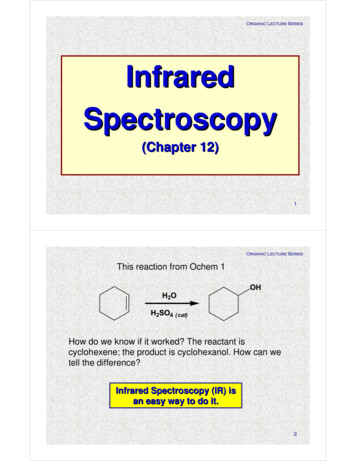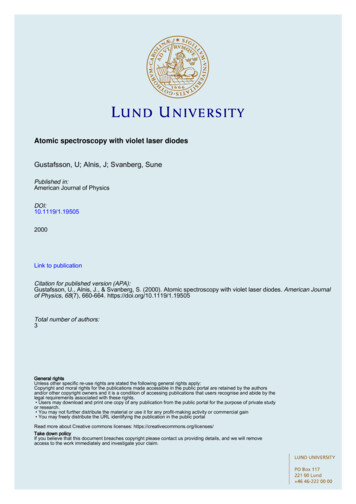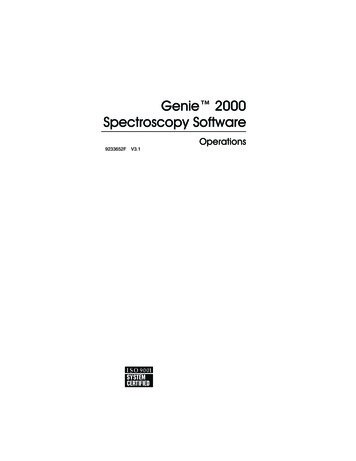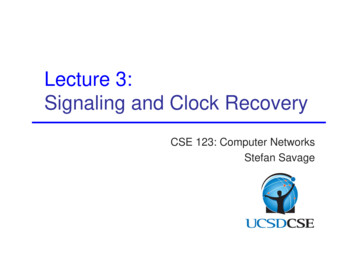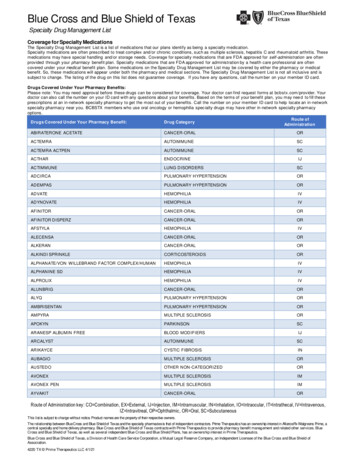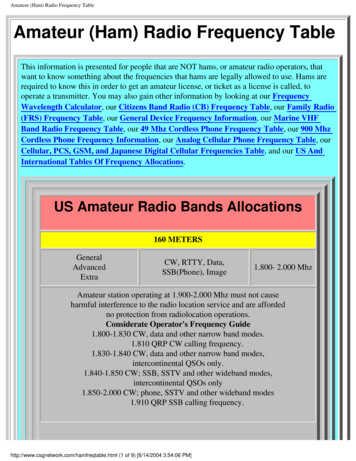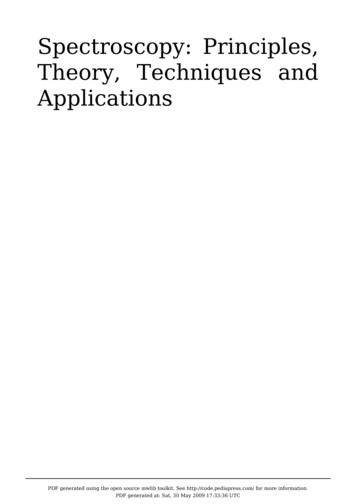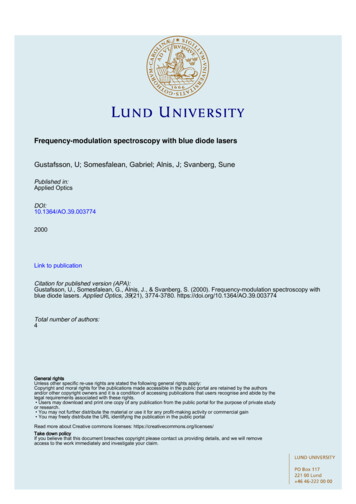
Transcription
Frequency-modulation spectroscopy with blue diode lasersGustafsson, U; Somesfalean, Gabriel; Alnis, J; Svanberg, SunePublished in:Applied OpticsDOI:10.1364/AO.39.0037742000Link to publicationCitation for published version (APA):Gustafsson, U., Somesfalean, G., Alnis, J., & Svanberg, S. (2000). Frequency-modulation spectroscopy withblue diode lasers. Applied Optics, 39(21), 3774-3780. https://doi.org/10.1364/AO.39.003774Total number of authors:4General rightsUnless other specific re-use rights are stated the following general rights apply:Copyright and moral rights for the publications made accessible in the public portal are retained by the authorsand/or other copyright owners and it is a condition of accessing publications that users recognise and abide by thelegal requirements associated with these rights. Users may download and print one copy of any publication from the public portal for the purpose of private studyor research. You may not further distribute the material or use it for any profit-making activity or commercial gain You may freely distribute the URL identifying the publication in the public portalRead more about Creative commons licenses: https://creativecommons.org/licenses/Take down policyIf you believe that this document breaches copyright please contact us providing details, and we will removeaccess to the work immediately and investigate your claim.LUNDUNIVERSITYPO Box11722100Lund 46462220000
Frequency-modulation spectroscopy with bluediode lasersUlf Gustafsson, Gabriel Somesfalean, Janis Alnis, and Sune SvanbergFrequency-modulation spectroscopy provides ultrasensitive absorption measurements. The techniqueis especially adaptable to diode lasers, which can be modulated easily, and has been used extensively inthe near-infrared and infrared spectral regions. The availability of blue diode lasers now means that theaccessible wavelength region can be increased. We successfully demonstrate wavelength-modulationspectroscopy and two-tone frequency-modulation spectroscopy for the weak second resonance line ofpotassium at 404.8 nm and for the transition at 405.8 nm in lead, starting from the thermally populated6p2 3P2 metastable level. Information on the modulation parameters is obtained with a fitting procedure. Experimental signal-to-noise ratios at different absorption levels are compared with theoreticalsignal-to-noise ratios and show good agreement. Detection sensitivities of 2 10 6 and 5 10 6 forwavelength and two-tone frequency-modulation spectroscopy, respectively, for a 120-Hz bandwidth aredemonstrated. 2000 Optical Society of AmericaOCIS codes: 300.6260, 300.6380, 300.1030.1. IntroductionDiode laser absorption spectroscopy based on frequency modulation 共FM兲 is a commonly used methodfor fast and ultrasensitive detection of minute concentrations of gas.1– 6 The interaction between amodulated laser field and an absorbing sample leadsto the generation of an absorption-related signal thatcan be detected at the applied modulation, at an overtone, or at an intermediate frequency by use offrequency- and phase-sensitive electronics. Characteristically this process shifts the detection band to ahigh-frequency region, where the laser excess 共1兾f 兲noise is avoided. Although a variety of FM methodshave been implemented, they actually represent limiting cases of the same technique. Depending on thenumber of modulation tones, on the choice of modulation frequency relative to the spectral width of theabsorbing feature, and on the detection frequency,the methods are referred to as wavelengthmodulation spectroscopy 共WMS兲,7 single-tone FMThe authors are with the Department of Physics, Lund Instituteof Technology, P.O. Box 118, SE-221 00 Lund, Sweden. J. Alnis ison leave from the Institute of Atomic Physics and Spectroscopy,University of Latvia, Rainis Boulevard 19, LV-1586 Riga, Latvia.The e-mail address for S. Svanberg is sune.svanberg@fysik.lth.se.Received 28 October 1999; revised manuscript received 21 April2000.0003-6935兾00兾213774-07 15.00兾0 2000 Optical Society of America3774APPLIED OPTICS 兾 Vol. 39, No. 21 兾 20 July 2000spectroscopy 共STFMS兲,8 or two-tone FM spectroscopy共TTFMS兲.9In WMS the modulation frequency is much smallerthan the half-width of the absorbing feature, whereasSTFMS and TTFMS are characterized by modulationfrequencies that are comparable to or larger than thehalf-width of the absorbing feature. WMS is usuallyperformed at kilohertz frequencies 共low-frequencyWMS兲, with conventional lock-in amplifiers used forsignal detection. For maximum sensitivity a largeFM index, defined as the ratio between the maximumfrequency deviation and the modulation frequency, isrequired. The sensitivity can be significantly improved by use of megahertz modulation frequencies共high-frequency WMS兲 and harmonic detection atmoderate FM indices.10 –12 Inasmuch as STFMSand TTFMS use high modulation frequencies, highsensitivity can be achieved with a low FM index.10 –12STFMS used for broad atmospheric-pressure lineswith linewidths of some gigahertz requires detectionelectronics with matching bandwidths. Such instruments are complicated, expensive, and not alwaysavailable in the wavelength region of interest.TTFMS circumvents this problem by using high FMof the laser at two closely spaced frequencies anddetecting the signal at the difference frequency, oftenin the megahertz range. Thus, in TTFMS it is possible to use detection electronics of moderate bandwidth and still preserve high sensitivity at a low FMindex. In the high-FM techniques 共high-frequencyWMS, STFMS, and TTFMS兲, the lock-in amplifier is
replaced by discrete components. The use of FM athigh frequencies offers the possibility of quantumnoise-limited detection.13–17Diode lasers are especially well suited for highsensitivity absorption spectroscopy because one canboth tune their emission wavelengths over the wholeabsorption profile by changing the temperature of thelaser capsule and modulate their frequencies directlyby applying an ac current on the drive current. Recently the Nichia Corporation introduced blue cw GaNdiode lasers that emit near 400 nm.18 Gustafsson etal.19 recently demonstrated the usefulness of these lasers for spectroscopy by performing experiments withpotassium vapor. No attempts at sensitive detectionwere made in these experiments, which employed direct absorption, laser-induced fluorescence, and optogalvanic spectroscopy. Here we extend this study byusing the blue diode laser and perform WMS andTTFMS on potassium as well as on lead. We studythe second resonance line, 4s 2S1兾2–5p 2P3兾2, in potassium 共39K兲 at 404.8 nm. We also record the transitionin lead 共208Pb兲 at 405.8 nm, starting from the thermally weakly populated 6p2 3P2 metastable level situated 1.3 eV above the ground state. Absorptionsignals are measured at different temperatures andthus at different absorptions. By means of a fittingprocedure, information regarding the modulation parameters is obtained. We examine the possibilities ofmaking highly sensitive absorption measurements inwhat is for diode lasers a new and interesting wavelength region and compare experimentally deducedand theoretically calculated signal-to-noise ratios共SNR’s兲. To achieve high sensitivity for both WMSand TTFMS, we perform WMS in the high-frequencywavelength-modulation regime, applying a modulation frequency of 5 MHz and detecting the second harmonic at 10 MHz, whereas for TTFMS we usemodulation frequencies near 900 MHz, i.e., larger thanthe Doppler widths 共HWHM兲, which are less than 800MHz for the transitions studied and detect beat signalsat the same frequency as for WMS.2. ExperimentA schematic of the setup for WMS and TTFMS experiments is shown in Fig. 1. The blue diode laser共Nichia NLHV500兲 has a nominal wavelength of 404nm at 25 C and a typical output power of 5 mW.The laser diode is placed in a thermoelectricallycooled mount and is current and temperature controlled by a precision diode laser driver 共Melles Griot06DLD103兲. The diverging laser beam is collimatedby a molded glass aspheric lens 共Geltech C230TM-A兲and is divided by a neutral-density filter. One partof the beam is transmitted through a small electrically heated oven into which either a 4-cm-long potassium cell or a 3.5-cm-long lead cell is placed. Theother part of the beam is directed through a lowfinesse confocal Fabry–Perot etalon 共free spectralrange, 1.5 GHz兲 for frequency calibration of the absorption spectrum. Both beams are focused on detectors that contain p–i–n photodiodes 共HamamatsuS-1190兲 and homemade transimpedance amplifiers.Fig. 1. Experimental setup for direct absorption spectroscopy,WMS, and TTFMS of potassium and lead vapor in sealed-off cells.Wavelength scanning is achieved by repetitive application of a rectangular current pulse 共TektronixRG501兲 with a duration of 1–2 ms and a repetitionrate of 100 Hz to the diode laser drive current, whichis biased below the threshold current. A heatinduced constant-current wavelength shift is produced during the rectangular current pulse if the risetime of the pulse is short compared with the growthrate of the junction temperature. This wavelengthscanning technique minimizes variations in laser intensity and spectral characteristics and ensures analmost constant FM index during the scan.20,21 Italso permits simultaneous recording of the absorption line and of the zero intensity level in direct absorption. The free-running laser typically lases on afew modes separated by 0.05 nm, as evidenced in aseparate test with a high-resolution spectrometer.However, judicious choices of temperature and drivecurrent ensure nearly single-mode operation.The FM schemes for WMS and TTFMS are almostidentical; the only difference is in the method of generating the modulation frequencies. In TTFMS wegenerate the two modulation frequencies by mixing a905-MHz signal 共Wavetek 2510A兲 and a 5.35-MHzsignal 共Tektronix SG503兲 in a frequency mixer 共MiniCircuits ZFM-4H兲. For WMS, only the 5.35-MHzmodulation frequency is used. The modulation current, before it is superimposed upon the laser drivecurrent, passes a variable attenuator, which allowsthe radio-frequency 共rf 兲 power to the diode laser to bevaried. We detect the TTFMS and WMS signals bymixing 共Mini-Circuits ZFM-3兲 the amplified 共MiniCircuits ZFL-1000LN兲 beat and second-harmonic signals 共at 10.7 MHz兲 from the detector with thefrequency-doubled 共Mini-Circuits FD-2兲 and appropriately phase shifted 共Synergy PP-921兲 5.35-MHzsignal. We adjust the rf power for the highest possible WMS and TTFMS signal amplitudes that can beachieved without the introduction of any significantmodulation broadening. We split off 共Mini-CircuitsZFRSC-2050兲 one part of the detector signal beforethe frequency mixer so we can observe the direct20 July 2000 兾 Vol. 39, No. 21 兾 APPLIED OPTICS3775
absorption signal. Where appropriate, bandpass-,high-pass, and low-pass filters are inserted to preventthe modulation frequencies from reaching the demodulation mixer, the detection frequency signal fromreflecting back toward the laser, and the modulatedabsorption-related signals from influencing the directabsorption signals. The direct and demodulated signals are amplified and low-pass filtered at 30 kHz inlow-noise preamplifiers 共Stanford SR560兲 and thenaveraged 256 times in a digital oscilloscope 共Tektronix TDS520B兲. Thus the effective bandwidth of thedetection system is approximately 120 Hz. Finally,the recorded waveforms are transferred to a computer for processing and evaluation.In WMS it is possible to record both the absorptionand the dispersion related to the probed medium.Here we consider only the absorption-related signalby making the appropriate choice of detection phase.We can do this because the in-phase 共0 or 兲 component of the signal corresponds to pure absorption,whereas the quadrature 共 兾2兲 component corresponds to pure dispersion. In TTFMS a small partof the dispersion component will fall into the detection angle, provided that the detection phase 共approximately 0 or 兲 is adjusted for optimum signalamplitude.22 However, for the transitions studied,the chosen modulation frequencies, and the precisionof the detection phase adjustment 共 5%兲, the dispersion component is less than 0.1% of the absorptioncomponent and is thus negligible.3. MeasurementsNatural potassium consists of two isotopes, 39K 共93%兲and 41K 共7%兲, both with a nuclear spin of 3兾2. Thestudied sealed-off potassium gas cell contains onlythe isotope 39K. We note that the existence of anonzero nuclear spin for potassium gives rise to ahyperfine splitting of the 4s 2S1兾2–5p 2P3兾2 transition.However, because of the small magnetic moment ofthe potassium nucleus, the hyperfine splittings aresmall; for 39K the ground-state splitting is only 462MHz and the upper-state splitting is 2 orders ofmagnitude smaller.23 Thus the Doppler-broadenedpotassium line, with a half-width of 800 MHz forthe temperatures used here, is not expected to showany structure.Typical recorded spectra for direct absorption andTTFMS measurements at 90 C in potassium areshown in Fig. 2, where the low-finesse etalon fringesare also displayed. The WMS line shape is almostidentical to that of TTFMS and is not shown. Because a rectangular current pulse is used for wavelength scanning, the laser output power is almostconstant during the scan, the zero intensity level canbe seen in the direct absorption recording, and thefrequency sweep is quite nonlinear. This meansthat neither any laser output power rectification norany separate zero intensity recording is necessarywith direct absorption. It means, though, that thefrequency scale has to be linearized, and subsequently this was done for all the spectra shown in theremaining part of this paper.3776APPLIED OPTICS 兾 Vol. 39, No. 21 兾 20 July 2000Fig. 2. 共a兲 Direct absorption and 共b兲 TTFMS spectra of the 4s2S1兾2–5p 2P3兾2 line at 404.8 nm recorded with a rectangular current pulse. 共c兲 Corresponding recording of the Fabry–Perot etalonfringes.WMS and TTFMS line shapes for potassium vaporwere recorded from 90 C to room temperature. InFig. 3, linearized recordings at 60 and 30 C, corresponding to peak absorptions of 1.6 10 3 and 6.7 10 5, respectively, are displayed. Interferencefringes, caused by reflections between the neutraldensity filter and the detector surface, are clearlyvisible in the recording of the TTFMS line shape at30 C. Although FM spectroscopy offers the possibility of quantum-noise-limited detection, the minimum achievable sensitivity is in practice often set byFig. 3. Linearized 共a兲 WMS and 共b兲 TTFMS recordings for potassium at two cell temperatures.
position of the mode jump varies in time, and thisvariation adds an irregular background to the recorded line shapes.4. Results and DiscussionFig. 4. Linearized 共a兲 WMS and 共b兲 TTFMS recordings of the lead405.8-nm line. Inset, diagram of the structure of lead.interference fringes that are seen as a periodicallyoscillating background and originate from spuriousreflections along the laser beam path. The interference effect can often be removed or largely reduced bycareful angling of all transmissive optics, and, as canbe seen from the WMS recording in Fig. 3 关uppercurve 共a兲兴, a slight adjustment of the neutral-densityfilter removes the interference fringes.It is necessary to perform experiments at considerably higher temperatures if one wishes to observethe absorption in lead, because of the low vapor pressure of this metal. We studied the transition at405.8 nm, starting from the thermally weakly populated 6p2 3P2 metastable level situated 1.3 eV abovethe ground state. The lead experiments were performed at temperatures that ranged from 500 to700 C, corresponding to ground-state atomic densities of 2 1017 m 3 to 7 1019 m 3 and to Boltzmannfactors of 2 10 8 to 9 10 7. These atomic densities can be compared with those in the potassiumcell, which range from 3 1014 m 3 共20 C兲 to 3 1017 m 3 共90 C兲. The lead gas cell contains a natural mixture of lead isotopes, but the specific measurements were performed on the transitioncorresponding to the 208Pb isotope with a nuclear spinof 0. The isotope, which has no hyperfine splittingbecause of the zero nuclear spin, has a Doppler widthof 550 MHz.The linearized WMS and TTFMS recordings at600 C 共peak absorption, 2.0 10 4兲 are shown inFig. 4. These recordings were also influenced by interference fringes that originated from a reflectionfrom the detector surface back into the diode lasercavity. Despite cautious angling of all optics as wellas of the diode laser and the detector, we were notable to suppress completely the interference fringesin the lead experiments. We explain the differencein the results of the experiment with potassium fromthat with lead as being due to different diode laserbehaviors at the two wavelengths because differentcurrent and temperature settings were used. Another unwanted and limiting effect in the lead experiments is a diode laser mode jump close to thetransition on the low-frequency side. The frequencyHere we first determine the modulation parametersin WMS and TTFMS by means of a fitting procedureof the recorded line shapes. Then we use these modulation parameters to calculate the theoretical SNR’sand compare them with the experimentally deducedSNR’s. Finally, we estimate the maximum achievable sensitivity of this blue diode laser– based spectrometer. The evaluation was performed mainlywith the experimental data for potassium, because,as we noted above, the lead experiments were hampered by interference fringes and a diode laser modejump, in which case, the SNR was set by these effectsrather than by the fundamental noise sources in aFM spectrometer. The formalism that describes theFM theory, including calculations of WMS andTTFMS line shapes and SNR’s, can be found, e.g., inRefs. 22 and 24 –26.FM of diode lasers is always accompanied by residual amplitude modulation 共RAM兲, which is noticeablein WMS and TTFMS recordings as a line-shapeasymmetry. This RAM, which is accounted for inthe FM theory by the AM index M and the AM–FMphase difference , is an effect that is caused by thelaser intensity not being exactly uniform over the FMrange, and it is undesirable because it carries some ofthe low-frequency noise into the FM signal. The AMindex and the AM–FM phase difference are closelyconnected in theory and are difficult to determineindependently. A value of 兾2 for the AM–FMphase difference is generally considered to be a goodapproximation for diode lasers,22,27,28 and, in whatfollows, we adopt this value.As we mentioned above, the studied transition inpotassium actually consists of several hyperfine components. These can be divided mainly into twoGaussians that have a half-width given by the Doppler width, are separated by 462 MHz and have anintensity ratio of 5兾3, which is equal to the statisticalweights of the two hyperfine ground-state levels 共F 2 and F 1兲. The FM index, designated in the FMnomenclature, and the AM index M were determinedby fits to the WMS and TTFMS line shapes recordedat different temperatures. The parameters obtained were 230 and M 0.045 for WMS and 1.0 and M 0.035 for TTFMS. With these parameter values, two curves were calculated, and they andtheir sum are displayed in Fig. 5, together with thepotassium line experimentally recorded at 80 C.The AM–FM index ratio M兾 is an intrinsic property of a diode laser and depends on the modulationfrequency and the bias current.29 Typically, the ratio scales with the modulation frequency, and for ourexperiments with equal bias current for WMS andTTFMS the ratio of the AM–FM index ratio forTTFMS and WMS was 179, which is in excellentagreement with the ratio of the modulation frequencies, 181.20 July 2000 兾 Vol. 39, No. 21 兾 APPLIED OPTICS3777
the numerator is the time-averaged mean-squareddetector current. e is the charge of the electron, isthe detector quantum efficiency, h is Planck’s constant, is the transition frequency, P0 is the laserpower, Q共 , 兲 is a signal that is due to absorption and dispersion , M is the AM index, N is the numberof modulating tones, f is the detection bandwidth, kis Boltzmann’s constant, T is the absolute temperature of the detector, RL is the resistance of the detection system, R共M兲 is the RAM function, p is thestandard deviation of the laser power within thenoise equivalent bandwidth of the detector system, fis the detection frequency, and ex is a systemdependent constant that is defined as the laser powerfluctuations at 1-Hz bandwidth at 1-Hz frequency.The value of the exponent b is typically 1.0 but canrange from 0.8 to 1.5.The absorption- and dispersion-related line-shapefunction Q共 , 兲, which depends on M, and , iscalculated as the peak-to-peak value of the absorption component of the WMS and TTFMS line shapesbecause the dispersion component vanishes as a result of our choice of detection phase. The RAM function describes the nonzero signal that is detectedeven in the absence of absorption and is due to theAM. The reason for employing second-harmonic detection instead of first-harmonic detection in WMS isthat the influence of RAM will be decreased. ForWMS and second-harmonic detection, R共M兲 1兾4 M 2cos共2 兲; for TTFMS, R共M兲 M2. The totalpower impinging upon the detector is P0 3 mW, andthe parameters for detector and detection electronicsin our setup are 0.37 and RL 50 . Fromdirect absorption measurements, a value of 1 10 3P0 for the parameter p was deduced. The only adjustable parameter in the SNR calculations is ex,and its value is estimated to be 4.5 10 4 P0. Thesevalues of p and ex are approximately 1 order ofmagnitude higher than typical values for diode lasersused for FM in the near infrared and the infrared.10,14We attribute the difference to the multimode behavior of our blue diode laser.Fig. 5. Observed 共symbols兲 and calculated 共solid curves兲 lineshapes for 共a兲 WMS and 共b兲 TTFMS of the potassium transition.The modulation parameters are 230 and M 0.045 for WMSand 1.0 and M 0.035 for TTFMS.It can be observed from the experimental data thatthe signals 共peak-to-peak value兲 in WMS are approximately 20% higher than those of TTFMS; see Fig.3–5. This result agreed well with the theoreticallycalculated signal values that yielded a signal difference for the temperatures employed of 21% for potassium and 23% for lead. No modulationbroadening is observed in either the WMS or theTTFMS line shape. This result is consistent withthe experimentally applied rf powers, which we carefully adjusted for the highest signal amplitudesachievable without introducing modulation broadening. The presence of modulation broadening wouldmake the fitting procedure more difficult and lessaccurate. WMS and TTFMS line shapes that wereoptimized only for maximum signal amplitudesshowed considerable modulation broadening.In a frequency-modulated system the power SNRPcan be expressed as25SNRP 具is共t兲典22222isn ith iRAM iex冉冊2e 2具P0典2兩Q共 , 兲兩2h 2N2e M24kTe e 2具P0典 1 f f 2R共M兲 p2 h 2RLh h 冉冊where the terms in the two expressions are in thesame order and where the mean-squared noise currents in the denominator 共from left to right兲 are related to laser-induced detector shot noise, detectorand amplifier thermal noise, AM-induced 共RAM兲noise, and laser source or excess noise and the term in3778APPLIED OPTICS 兾 Vol. 39, No. 21 兾 20 July 2000冉冊冉冊2 f 2 exfb,(1)The experimental SNR is calculated as the ratio ofthe line-shape peak-to-peak value to the noise rmsvalue. Inasmuch as we measure voltage and notpower, the experimental SNR is related to the theoretical voltage SNRV, which is given by SNRV 共SNRP兲1兾2. In Fig. 6 the experimental SNR’s for
Fig. 6. Experimentally deduced SNR’s for WMS 共diamonds兲 andTTFMS 共triangles兲 for potassium together with theoretical curvescalculated from Eq. 共1兲 and the parameter values mentioned in thetext.WMS and TTFMS are presented, together with thetheoretical SNR curves. Clearly, absorption signalsfor less than the smallest experimentally recordedabsorption of 2 10 5 共at 20 C兲 are detectable, butwith our current setup it is not possible to cool the gascell and record signals below room temperature.The sensitivity limits that can be deduced are 2 10 6 for WMS and 5 10 6 for TTFMS. In the leadexperiments we were able to record WMS andTTFMS signals down to a SNR of 1, which occurs attemperatures of 500 C and corresponds to an absorption of 5 10 5. Thus the interference fringesand the mode jump limit the detection sensitivity by 1 order of magnitude.There are two reasons for the approximately twotimes better SNR in WMS than in TTFMS. The firstis the higher signal amplitude in WMS, and the second is the higher RAM noise level in TTFMS, asexpected from the different RAM dependencies givenby the RAM function. All other noise sources havethe same amplitude in WMS and TTFMS. The ratioof the shot noise, the thermal noise, the laser excessnoise, the TTFMS RAM noise, and the WMS RAMnoise is 1:1.7:0.7:5.4:2.2. These numbers clearlyshow that TTFMS is essentially limited by RAMnoise, whereas the sensitivity in WMS is set by bothRAM and thermal noise. We also note that the laserexcess noise is below the shot noise and that the mainpurpose for employing FM is achieved. RAM noiseand, as a consequence of the technique, laser excessnoise can be greatly reduced by the use of balancedhomodyne detection.13,15,21 However, the powertransmitted through the absorbing medium is halvedand the thermal noise is doubled in this technique.Theoretical calculations of the SNR’s in balanced homodyne detection, with the same parameter valuesas above, show that the SNR’s for TTFMS are almostthe same but that the SNR’s for WMS are lower, aswe also verified experimentally. The results ob-tained in the present study are broadly in line withthose obtained in previous comparisons of the sensitivity of various modulation schemes in which infrared lead-salt diode lasers10 and near-infrared GaAlAsdiode lasers11 were used.A possible extension of the present study would beto monitor NO2, which has strong absorption bandsin the wavelength region about 400 nm. At atmospheric pressure these transitions are much broaderthan for potassium and lead and might also partiallyoverlap. Such a study would require continuousscans of the order of 50 GHz, which at present are notfeasible with the diode laser used. One should alsonote that the multimode behavior of the diode laserdoes not influence the spectral appearance for freeatoms with isolated spectral features as in our case,because only one of the oscillating modes interactswith the atoms. However, for molecules with a multitude of close-lying lines, multimode behavior is, ofcourse, unacceptable. As the blue diode laser used isa prototype laser, we believe that later versions willbe better suited for spectroscopy, i.e., will operate ina single mode. One can use an external-feedbackcavity to ensure single-mode operation and largefrequency-tuning ranges, but doing so will limit thehigh-FM capabilities and thus the detection sensitivity.5. ConclusionsWe performed FM spectroscopy on potassium andlead, using a blue diode laser. We made highly sensitive absorption measurements in this new and interesting diode-laser wavelength region, employingWMS and TTFMS. In fits to experimental data themodulation parameters for the blue diode laser usedin our experimental setup were determined. Wehave shown that experimentally deduced SNR’s arein good agreement with theoretically calculatedSNR’s. Additionally, various noise sources were examined, and we have concluded that TTFMS is dominated by RAM noise, whereas WMS is limited byboth RAM and thermal noise. A minimum detectable absorption of 2 10 6 for WMS and 5 10 6 forTTFMS in a 120-Hz detection bandwidth was observed. By sum-frequency mixing blue and red diode lasers, even shorter emission wavelengths can beachieved, further extending the possibilities for sensitive absorption spectroscopy of many atomic andmolecular transitions.30This study was supported by the Swedish ResearchCouncil for Engineering Sciences 共TFR兲 and the Knutand Alice Wallenberg Foundation. J. Alnis thanksthe Swedish Institute for a stipend supporting hisstay in Sweden.References1. P. Werle, R. Mücke, F. D. Amato, and T. Lancia, “Nearinfrared trace-gas sensor based on room-temperature diodelasers,” Appl. Phys. B 67, 307–315 共1998兲.2. G. Modugno, C. Corsi, M. Gabrysch, and M. Inguscio, “Detection of H2S at ppm level using a telecommunication diodelaser,” Opt. Commun. 145, 76 – 80 共1998兲.20 July 2000 兾 Vol. 39, No. 21 兾 APPLIED OPTICS3779
3. H. Riris, C. B. Carlisle, D. F. McMillen, and D. E. Cooper,“Explosives detection with a frequency modulation spectrometer,” Appl. Opt. 35, 4694 – 4704 共1996兲.4. J. A. Silver, D. J. Kane, and P. S. Greenberg, “Quantitativespecies measurements in microgravity flames with near-IRdiode lasers,” Appl. Opt. 34, 2787–2801 共1995兲.5. P. Kauranen, H. M. Hertz, and S. Svanberg, “Tomographicimaging of fluid flows by the use of two-tone frequencymodulation spectroscopy,” Opt. Lett. 19, 1489 –1491 共1994兲.6. P. Kauranen, I. Harwigsson, and B. Jönsson, “Relative vaporpressure measurements using a frequency-modulated tunablediode laser, a tool for water activity determination in solutions,” J. Phys. Chem. 98, 1411–1415 共1994兲.7. E. G. Moses and C. L. Tang, “High sensitivity laser wavelengthmodulation spectroscopy,” Opt. Lett. 1, 115–117 共1977兲.8. G. C. Bjorklund, “Frequency-modulation spectroscopy: a newmethod for measuring weak absorptions and dispersions,” Opt.Lett. 5, 15–17 共1980兲.9. G. R. Janik, C. B. Carlisle, and T. F. Gallagher, “Two-tonefrequency-modulation spectroscopy,” J. Opt. Soc. Am. B 3,1070 –1074 共1986兲.10. D. S. Bomse, A. C. Stanton, and J. A. Silver, “Frequency modulation and wavelength modulation spectroscopie
laser capsule and modulate their frequencies directly by applying an ac current on the drive current. Re-cently the Nichia Corporation introduced blue cw GaN diode lasers that emit near 400 nm.18 Gustafsson et al.19 recently demonstrated the usefulness of these la-sers for spe
